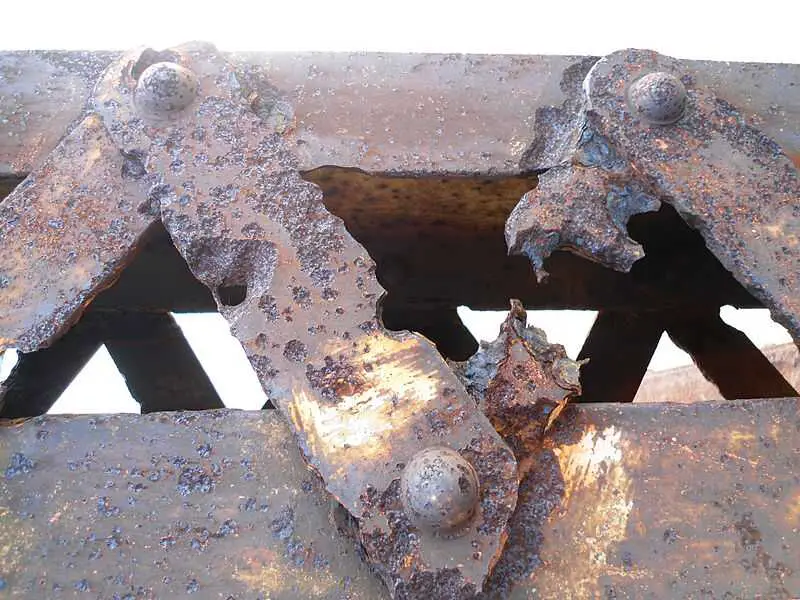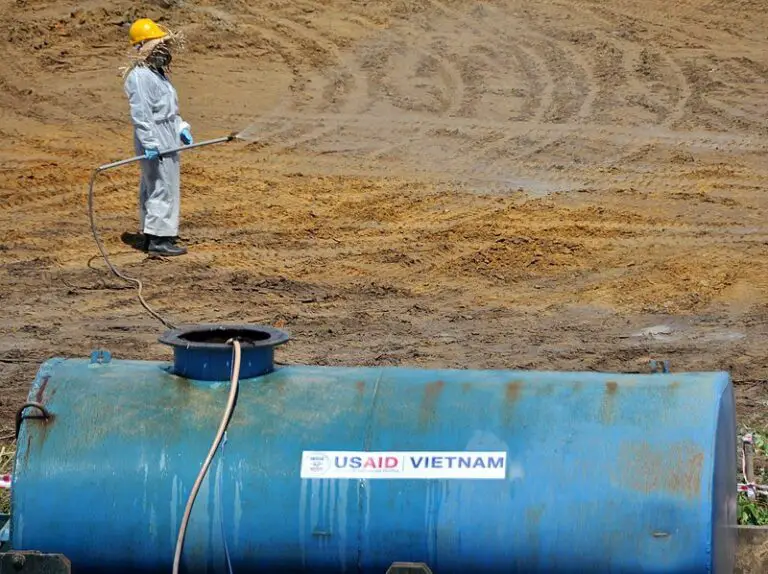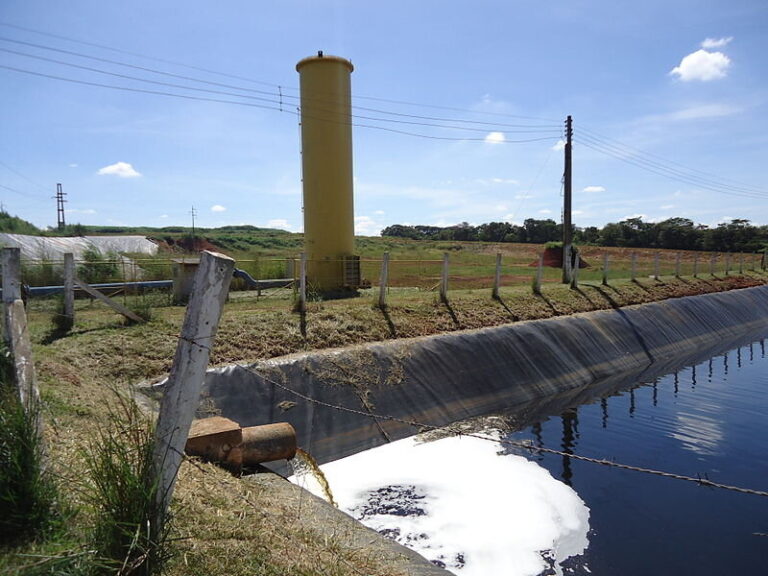7 Types of Corrosion and Their Characteristics Explained
Types of corrosion are; localized, uniform, galvanic, intergranular, pitting, stress corrosion cracking (SCC), and selective corrosions, respectively.
This article discusses the types of corrosion and their characteristics, as follows;
1). Localized Corrosion (as one of the Types of Corrosion)
Localized corrosion is a form of oxidative metal deterioration that does not occur evenly across the surface of the affected metal, but is rather concentrated intensely over small areas.
The opposite of localized corrosion is uniform or general-attack corrosion; which entails a uniformly-distributed rate and severity of deterioration [3].
Although localized corrosion may affect a large area of a metal, it is recognized by having significant severity and intensity only in some parts of the metallic surface or structure.
The explanation for this is a higher vulnerability in the affected areas, which occurs generally because one or more of the potential causes of corrosion is acting more intensely on these areas than adjacent ones. Such causative factors include humidity, acidity, and mechanical stress.
It is fairly common for localized corrosion to occur at joints (such as weldments) on a metallic structure [7], because these areas tend to be more prone to stress and humidity than others.
Also, it is important to understand that localized corrosion is a relatively-broad concept; which in fact covers some of the other types of corrosion, so that all types of corrosion with area-specific attributes can be classified as localized corrosion.
Types of localized corrosion are; crevice, cavitation and pitting corrosions respectively. In this article, the first two (crevice and cavitation) subtypes are not discussed, because they are very similar to pitting corrosion.
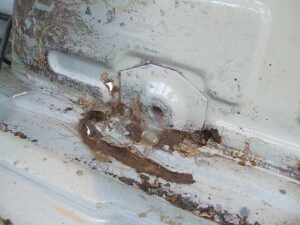
2). Uniform Corrosion
Uniform corrosion is a type of corrosion that is characterized by equal rate and severity of deterioration across the entire surface of a metal. An example of uniform corrosion is the gradual tarnishing of galvanized silver.
Localized types like pitting corrosion are the opposite of uniform corrosion because they concentrate intensely over a relatively-small area, and therefore do not have equal effect across a given metallic surface.
Other less concentrated types like galvanic corrosion, can be classified as uniform, because these types feature a more equal distribution of oxidation and deterioration rates.
In general, uniform corrosion does not result in rapid impairment and damage of metal materials compared to localized corrosion. Its damaging effect is rather slow, involving a progressive loss of volume of the affected tool, accessory or equipment.
Uniform corrosion is likely to occur on metals with a fair degree of chemical resistance and structural homogeneity, which are placed in an acidic and/or humid ambient medium with fairly stable conditions over time. These attributes reduce the chances of an intense chemical attack on a small area.
It is possible for uniform corrosion to transform into localized corrosion as it proceeds. This is especially a likelihood where the affected metal has a protective coating that offers initial resistance until it is worn down by corrosive agents, which subsequently attack the less-resistant material underneath.

3). Galvanic Corrosion (as one of the Types of Corrosion)
Galvanic corrosion is a type of metallic deterioration that affects dissimilar metals which are in electrical contact, so that one (the cathode) is protected while the other (anode) is corroded [1]. An example of galvanic corrosion is the preferential deterioration of a protective zinc coating on steel.
The term 'preferential' used above may be interpreted as being equivalent to selective, as in selective corrosion. However both concepts are different from each other, although having slight similarity.
The difference between galvanic and selective corrosions is that galvanic involves two distinct metals that are in contact, while selective deals with a mixture of two (or more) metals in an alloy.
Galvanic corrosion is also known as bimetallic corrosion, or dissimilar-metal corrosion; and is common in galvanized metal assemblies where the coating metal is less 'noble' and chemically-resistant than the coated metal.
It is also common for galvanic corrosion to occur in electrochemical cells where the anode disintegrates in the electrolyte.
Galvanic corrosion is sometimes described as being localized, because much of the deterioration is concentrated at the contact interface between the dissimilar metals.
4). Intergranular Corrosion
Intergranular corrosion (IGC) is a form of metallic chemical deterioration that occurs along the boundaries of metallic crystalline or grain-components in an alloy. A classic example of intergranular corrosion is the deterioration of chromium at grain boundaries in steel. This is often an oxidative process that results in the formation of chromium carbides (Fe,Cr)23C6) [6].
Another name used to refer to intergranular corrosion is intergranular attack (IGA).
The process of intergranular corrosion is a gradual one that is aggravated by high temperature, and proceeds with chemical reaction and oxidation.
Intergranular corrosion is localized, and often described as being selective.
Characteristics of intergranular corrosion are; temperature sensitivity, relatively-slow rate, grain-boundary concentration, and low effect on grain-interior.
5). Pitting Corrosion (as one of the Types of Corrosion)
Pitting corrosion is a highly-localized deteriorative process whereby concentrated oxidation leads to the formation of holes or 'pits' on metal surfaces.
As stated above, the outcome of this type of corrosion is a pockmarked or pitted surface where the most vulnerable metal components or areas have been worn down by chemical agents.
Pitting corrosion is also referred to as localized corrosion; of which it is a typical example. It is not uncommon for a singular case of metal deterioration to be described as pitting, cavitation and crevice corrosion, as these are all highly-localized forms of corrosion.
Other types like galvanic corrosion may also take the form of pitting corrosion, provided oxidation is concentrated in small areas and causes grooves to form in the affected metal.
Because it is very intense wherever it concentrates, pitting corrosion can have severe effects on the quality of metallic materials that it affects. It easily causes structural deformation, and is a common factor behind the damage of metal equipment.
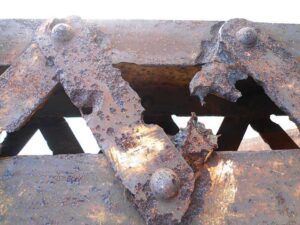
6). Stress Corrosion Cracking (SCC)
Stress corrosion cracking (SCC) is a type of corrosion that occurs in metals by the combined action of tensile stress and chemical attack.
Another name for stress corrosion cracking is chemo-mechanical fracturing; which highlights the factors involved in this process.
Three factors that are essential for the occurrence of stress corrosion cracking are, acidic-ambient media, relatively-high temperature, and tensile stress.
Stress corrosion cracking is unique in its involvement of stress, which acts as both an initiator and facilitator of the deterioration process. This applied stress ultimately leads to failure in most cases [5], and stress corrosion is associated with high hazard risk, engineering defects and loss of efficiency. Such outcomes can be attributed to the progressive breakage and growth or cracks in affected metals [4].
The types of stress corrosion cracking are intergranular and intra-granular; which occur at grain boundaries and in the interior of grains, respectively.
7). Selective Corrosion (as one of the Types of Corrosion)
Selective corrosion is a chemical deterioration process affecting mostly alloys, so that less-resistant metallurgic components are progressively oxidized and leached, or removed, from the alloy. An example is the oxidative removal of aluminum from aluminum-bronze alloy.
Other names for selective corrosion are; selective leaching, dealloying, parting and demetalification.
The most common form of selective leaching or corrosion is dezincification, which involves the loss of zinc from brass materials under acidic conditions. This generally results in a porous, copper residue formed by deterioration at both surface and bulk levels [2].
While structural integrity and metallurgical composition both degrade considerably, many materials that undergo selective corrosion retain their geometric form or outline.
Types of selective corrosion are; dealuminification, dezincification, desiliconification, decobaltification, and decarburization, among others. They are basically distinguished by the metallurgic composition of alloys involved.
Conclusion
Types of corrosion are;
1. Localized Corrosion
2. Uniform Corrosion
3. Galvanic Corrosion
4. Intergranular Corrosion
5. Pitting Corrosion
6. Stress Corrosion Cracking (SCC)
7. Selective Corrosion
References
1). Akpoborie, J.; Fayomi, O. S. I.; Agboola,.O.; Samuel, O. D.; Oreko, B. U.; Avoola, A. (2021). "Electrochemical Corrosion Phenomenon and Prospect of Materials Selection in Curtailing the Challenges." IOP Conference Series Materials Science and Engineering 1107(1). Available at: https://doi.org/10.1088/1757-899X/1107/1/012072. (Accessed 14 May 2023).
2). Ateya, B. G.; Al-Kharafi, F. M.; Hassan, F. M. (2006). "Selective Corrosion of Alloys." Available at: https://www.researchgate.net/publication/228709942_Selective_Corrosion_of_Alloys. (Accessed 14 May 2023).
3). Bell, T. (2019). "What is Corrosion?" Available at: https://www.thoughtco.com/types-of-corrosion-2340005. (Accessed 13 May 2023).
4). Khalifeh, A. (2019). "Stress Corrosion Cracking Damages." Failure Analysis. Available at: https://doi.org/10.5772/intechopen.80826. (Accessed 14 May 2023).
5). Khalifeh, A. (2020). "Stress Corrosion Cracking Behavior of Materials." Engineering Failure Analysis. Available at: https://doi.org/10.5772/intechopen.90893. (Accessed 14 May 2023).
6). Li, S-X.; He, Y-N.; Yu, S-R.; Zhang, P-Y. (2013). Evaluation of the effect of grain size on chromium carbide precipitation and intergranular corrosion of 316L stainless steel." Corrosion Science, Volume 66, January 2013, Pages 211-216. Available at: https://doi.org/10.1016/j.corsci.2012.09.022. (Accessed 14 May 2023).
7). Sephton, M.; Pistorius, C. P. (2000). "Localized Corrosion of Carbon Steel Weldments." Corrosion -Houston Tx- 56(12). Available at: https://doi.org/10.5006/1.3280516. (Accessed 14 May 2023).
